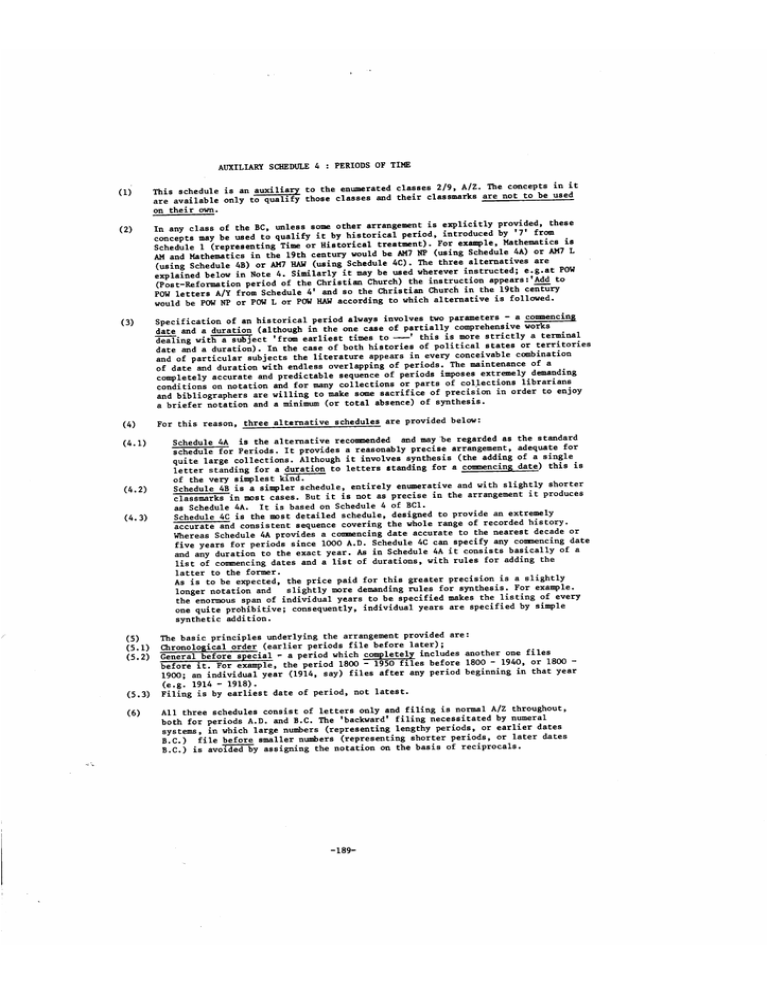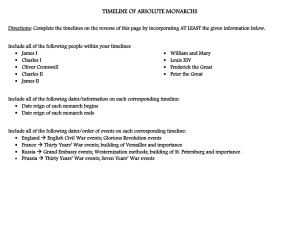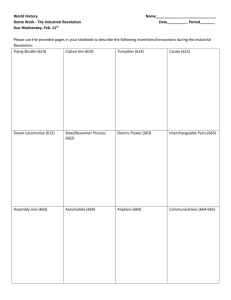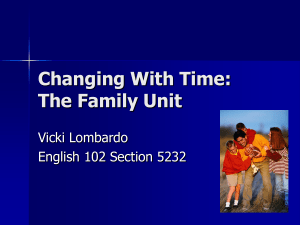periods of time. - Bliss Classification Association
advertisement

AUXILIARY SCHEDULE 4 (1) TIME it A/Z. The concepts in This schedule is an auxiliary to the enumerated classes 2/9, are not to be used classmarks their and classes those qualify to only are available on (2) : PERIODS OF their own. other arrangement is explicitly provided, these historical period, introduced by '7' from concepts treatment). For example, Mathematics is Historical or Time (representing 1 Schedule be AM7 NP (using Schedule 4A) or AM7 L would century 19th the in Mathematics and AM alternatives are (using Schedule 4B) or AM7 HAN (using Schedule 4C). The three instructed; e.g.at POW may be used wherever explained below in Note 4. Similarly appears:'A§d to (Post-Reformation period of the Christian Church) the instructionthe 19th century the Christian Church in POW letters A/Y from Schedule 4' and so is followed. would be POW NP or POW L or POW HAW according to which alternative In of the BC, may be used to any class unless qualify some it by it (3) (4) (4.1) (4.2) commencing — a Specification of an historical period always involves two parameters works date and a duration (although in the one case of partially comprehensive a terminal dealing with a subject ‘from earliest times to-—-' this is more strictly states or territories date and a duration). In the case of both histories of political combination and of particular subjects the literature appears in every conceivable of a of date and duration with endless overlapping of periods. The maintenance demanding completely accurate and predictable sequence of periods imposes extremelylibrarians conditions on notation and for many collections or parts of collections in order to enjoy and bibliographers are willing to make some sacrifice of precision a briefer notation and a minimum (or total absence) of synthesis. this reason, three alternative schedules are provided below: For the standard Schedule 4A is the alternative recommended and may'be regarded as provides a reasonably precise arrangement, adequate for schedule for Periods. It a single quite large collections. Although it involves synthesis (the adding of letter standing for a duration to letters standing for a commencing date) this is of the very simplest kind.‘ slightly shorter Schedule 4B is a simpler schedule, entirely enumerative and with It (4.3) it it produces is not as precise in the arrangement classmarks in most cases. But is based on Schedule 4 of BCl. as Schedule 4A. Schedule 4C is the most detailed schedule, designed to provide an extremely accurate and consistent sequence covering the whole range of recorded history. or decade Whereas Schedule 4A provides a commencing date accurate to the nearest commencing date five years for periods since 1000 A.D. Schedule 4C can specify any basically of a consists and any duration to the exact year. As in Schedule 4A of durations, with rules for adding the list of comencing dates and a latter to the former. is a slightly As is to be expected, the price paid for this greater precision slightly more demanding rules for synthesis. For example. longer notation and the enormous span of individual years to be specified makes the listing of every by simple one quite prohibitive; consequently, individual years are specified list it synthetic addition. / (5.3) I basic principles underlying the arrangement provided are: later); Chronological order (earlier periods file before General before special — a period which completely includes another one files before it. For example, the period 1800 - 1950 files before 1800 - 1940, or 1800 in that year 1900; an individual year (1914, say) files after any period beginning (e.g. 1914 - 1918). Filing is by earliest date of period, not latest. (6) All (5) (5.1) (5.2) The three schedules consist of letters only and filing is normal A/Z throughout, both for periods A.D. and B.C. The 'backward' filing necessitated by numeral systems, in which large numbers (representing lengthy periods, or earlier dates B.C.) file before smaller numbers (representing shorter periods, or later dates B.C.) is avoided by assigning the notation on the basis of reciprocals. -189- A Bibliographic Classification AUXILIARY SCHEDULE 4A : PERIODS OF TIME (1) This is an alternative to Schedules (2) Apart from the enumerated periods at (2.1) a (2.2) a list list it C/DE a Any (4) Where the comencing date enumerated date — e.g. if CE CG CJ period) - Table 2 between two enumerated commencing dates, use the the commencind date is 1848, use 1845 (PL) earliest duration falls between 2 enumerated durations, take the next largest - e.g.for a duration of 11 years use 20 years; so the period 1848-1859 would be coded as PLX (1845-1865) Where the To 2000 A.D. CL 1940 1900 1800 CM CN CP CQ DA DAG 4 1 falls Periods from the earliest times * For works which include prehistoric times CC at beginning of Schedule consists of of approximate commencing dates - Table of durations(numbers of years in see notes 3/6 given period is obtained by adding a single letter from Table 2 directly to a comencing date from Table 1; e.g. to code 1800-1900 the commencing date code for 1800 is taken (N) and the duration code for 100 years (P) is added directly,to give NP. Every classmark must contain both these components (3) (5) 4B and 4C; (STANDARD SCHEDULE) Prehistory (from earliest times to Geological eras ' » as well as historic (recorded) To 1700 A.D. 1600 1500 1000 500 CR CT CV time To 000 500 1000 (4000 A.D. B.C. B.C. B.C.) sis DA B.C.) 4000 (Cultural epochs) * There is no agreement on the commencing dates of the following, or their duration; both vary widely according to place and context. They are given here on the grounds of literary warrant- DAP DAR DB DC DD DE Palaeolithic Mesolithic Neolithic Ancient, medieval and odern history Ancient and medieval history Ancient history (c. 4000 B.C.- 500 A.D.) Table 1 (Schedule 4A) : Comencing dates of periods * These codes cannot be used on their own; * See notes 2/5 for rules they must be followed by a letter from Table 2 (Duration) 7 Periods beginning in DF DG DH DJ DK DL DM DN D0 DP DQ 4000 B.C. 3900 3800 3700 3600 3500 3400 3300 3200 3100 3000 Periods beginning in EB EC ED EE EF EG EH EJ EK EL ET 900 800 700 600 500 400 300 200 EU 100 EV O00 EM DR DS DT .. t DU DV DW DX DY DZ EA 2900 2800 2700 2600 2500 2400 2300 2200 2100 2000 1900 'B.C. 1800 1 700 1600 1500 1400 1300 1200 1100 1000 EN E0 EP EQ ER ES EW FA 200 300 400 450 FB Medieval period EX EY EZ * There is no agreement on the exact dates or duration of this* For periods from and including Medieval period, add to FA e.g. Medieval era to present day, FC FD FE FF FG FH FJ -190- Periods beginning in 100 A.D. A.D. FK " 500 600 700 800 900 1000 1020 1040 FAK Auxiliary Schedule 4A Periods beginning in : Periods of time (Standard schedule) Periods beginning in 1060 A.D. 1080 1100 1120 1140 1160 1130 1200 1220 1240 1260 1280 1300 1320 1340 HS HT HV HW HX J KF -KG KH KJ or duration of this. * For periods from and including the Renaissance, add to FZ e.g. Renaissance to 1750, FZL 1350 1360 1370 1380 1390 1400 1410 1420 1430 1440 1450 1460 1470 1480 1490 1500 1505 1510 1515 1520 1525 1530 1535 1540 1545 1550 1555 1560 1565 KK KL KM KN KP KQ KR KS KT KV KW KX 1800 A . D 1805 1810 1815 1820 1825 1830 1835 1840 1845 1850 1855 1860 1865 1870 1875 1330 1885 1890 1895 N PC PD PE PF PG PH 1600 1605 1610 1615 1620 1625 1630 1635 1640 1645 1650 1655 1660 1665 1670 1675 1680 1685 1690 1695 KC KD KE Renaissance * There is no agreement on the exact dates Periods beginning in 1570 A.D. 1575 1580 1585 1590 1595 HR PJ PK PL PM PN PP PQ PR ' P5 PT PV PW PX 1900 1905 1910 1914 1914-18 * For periods from and _ 1700 1705 1710 1715 1720 1725 1730 1735 1740 1745 1750 1755 1760 1765 1770 1775 1780 1785 1789 MF MG MM MJ MK * For periods from ‘ and RKX 1940 1945 1950 1955 1960 1965 1970 1975 1980 1985 1990 1995 2000 RM RN R0 RP RQ RR RS RT RV including MS RW . - e.g. 1789-1848, RY RZ MST S Table * These codes cannot * 2 from Table 1 notes 2/5 above See (Schedule 4A) be used on their Duration (number of years in own; they must be added to a period) specific Duration in zears 200 2500 2000 1500 1000 800 700 500 400 a for rules Over 4000 years 4000 3000 .8» : -191- including 1939/1945, add to RK - e.g. 1939/1950, 1789-1815 add to 1935-45 RL * For periods from and RC 1919 1920 1925 1930 1935 1939 1789-1815 , including 1914/1918,add to commencing date taken A (1) (2) (3) (4) Bibliographic Classification Auxiliary Schedule 4B : Periods of Time (for broad classification) This is an alternative to Schedules 4A and 4C; see note at the beginning of Schedule 4. It is a fully enumerated schedule, consistent with Schedule 4 in BC1, but much fuller in its detail All periods file by initial date, then duration. A period which completely includes another one files before in the earliest preceding a period overlaps two or more of the enumerated periods, class - e.g. 1715-1789 is classed as 1700-1800. period which completely includes it. If it it earliest Periods from the times ABK ABL ABM ABN ABP ABQ B0 BP BQ BR BS BT BU BV BW BX (4000 BC) see ABR Prehistory (from earliest times to ABR ABS (Cultural epochs) Palaeolithic Mesolithic Neolithic AF AJ AL AM AN A0 AP (Periods - AD) 000 - 2000 AD 000 - 1500 000 - 1000 O00 - 00 5 000 - 100 AQ AR AS AT AU 10° AV AW AX 200 300 '- 20° 300 400 B exact iw TP nearest approximation. $3 A - 45° ' 1200 '- BF BC BH 800 soo 1930 191856 Zgigeo 1960 - 1970 1970 - 1980 1975 — zooo 1980 - 1990 TV TW TX TY V -192- ‘1940193° 192345 505350 TU 1450 1100 - 192238 203345 1945 1960 ii 1°00 450 soo 450 - 500 500 600 700 600 700 800 BE 192° ST SV dates or duration of the Mediaeval period but this is probably the 450 BB 1918 - 1945 1918 - 1939 2% 400 - 500 450 - 2000 . . 450 - 1450 Mediaeval period * There is no agreement on the AX AZ BK KT KV - 500 BC - 000 AD 500 - 400 BC 400 - 300 BC 300 - 200 BC 200 - 100 BC 100 BC - 000 AD AK BJ - - AI Bn CV CX CY E - AG AH BC 191s1g1iodo1918 CS To 000 A.D. 3000 BC 000 AD 2000 BC 3000 2000 BC - 000 AD 1000 BC 2000 1000 BC 000 AD AE 1» gw CP Ancient, mediaeval and modern history Ancient and mediaeval Ancient history (recorded history, c.4000 BC to 500 AD) AC ACQ AD I RT C literary warrant. matter of 1350 - 1400 1400 - 1500 1450 - 2000 1450 - 1900 1450 - 1750 1450 - 1650 1450 - 1500 1500 - 1800 1500 - 1600 ' 1550 - 1600 1600 - 1800 1600 - 1700 1600 - 1650 1650 - 1750 1650 - 1700 1700 - 1800 1700 - 1775 1750 - 1800 1775 - 2000 1775 - 1850 1789 - 1815 1800 - 1900 1815 - 2000 1815 1900 1815 - 1830 1830 - 1900 1850 - 1875 1875 - 1900 1900 - 2000 1900 - 1975 1900 - 1945 1900 - 1914 BY BZ is no agreement on the commencing dates of the following, or on their duration; both vary widely according to place and context. They are given here as a * There Renaissance (c.1350 - 1550) * There is no agreement on the exact dates or duration of this period, but this is probably the most satisfactory position 4000 BC) Geological eras ABV ABX ABY - BM BN 1700 1600 1500 1000 500 000 500 BC 1000 BC ABJ 800 - 1000 800 900 900 - 1100 900 - 1000 1000 - 1450 1000 - 1300 1000 - 1100 1100 - 1200 1200 - 1450 1200 - 1300 1300 - 1450 1300 - 1400 BL T0 2000 AD 1940 1900 1800 ABD ABE ABF ABC ABH 2000 - 2100 199° ' 2°°° SCHEDULE 4Q * This is an (1) The alternative to : Periods of Time (for close Schedules 4A and 4B. See notes 3/6 at beginning of Schedule classmark for any period from 4000 B.C.or consists of (1.1) (1.2) (1.3) The code The for the commencing date classification) later and lasting for the number 4 single year of the period (from Table 1), followed by letter 'A' (the indicator for period), followed The code more than a by of years in the period (from Table 2) e.g. to code the period 1800-1950, the code for 1800 A.D. is taken from Table 1 i.e. H; 'A' is added - i.e. HA; the code for the number of years duration is taken from Table 2 - i.e. VT for 150 years. This gives the full classmark HAV T. (2) Every period exceeding one year must contain the (3) Classmarks for single years must be built according to the instructions in the two tables The dates in Table (apart from the enumerated periods at C/DE) cannot be used on their own - they are purely for purposes of period classmark building. For example, H 1800 has 'A' added to to introduce a period as shown above; 'B' added to any commencing date denotes the single year itself - so HB is the single year 1800 A.D. (which, of 3 elements above in its classmark l it course, files after any period within that period). C To 1980 A.D. 1960 CP 1940 1920 1900 1800 CQ CR Cs CVE DAP DAR DB DC DD DE 4% in that year, since it is completely contained TABLE l (Schedule 4C) : Commencing dates of periods * Except for classes C/DE these codes cannot be used on their own. Periods from the earliest times * For works including both pre-history and historic (recorded) periods * The following are likely to suffice for most libraries. For libraries wishing to specify to the exact year, an expansion of this is provided in Table 3. co DA DAG commencing To 1700 A.D. CVK Cvp 1600 1500 1000 500 000 QVV Cwy cxp; CXL Prehistory (from earliest times to Geological eras To CXQ Cxw CYJ CYT 500 B.C. 1000 2000 3000 (4000 B.C.) §_e£ DA Prehistory 4000 B.C.) (Cultural epochs) * There is no agreement on the commencing dates of the following, or on their duration; both vary widely according to place and context. They are given here as a matter of convenience Palaeolithic Mesolithic Neolithic Ancient, medieval and modern history * This period could be synthesised by adding to DF. This provides it with a briefer class mark. The same applies to DD and DE Ancient and medieval history Ancient history (c. 4000 B.C.- 500 A.D.) Periods beginning in any year between 4000 B.C. and 001 B.C. (classes DF/EUYU) * To code any individual year between 4000 B.C. and 001 B.C., add to the code first year of the century the letters C/YU following DF in DFC/DFYU below. for the Note that the first year of the century is always the next highest number, in two zeros, than the individual year sought; e.g. to code 2763 B.C., addending to the code for 2800 B.C. - i.e. DS; in the sequence DFC/DFYU the code for 63 i§_VS, so the classmark for 2763 is DSVS. * The letter 'B' added to any date represents the single year itself - e.g. DFB is the year 4000 B.C. itself. Periods beginning in Periods beginning in Periods beginning in DF DFC 4000 B.C. 3999 DFI J 3993 BJC. 92 -193- DFP 3986 B.C. DFV A C Bibliographic Classification Periods beginning Periods beginning in vp 78 77 76 75 74 73 72 71 70 V“ 69 VF VG vu v1 VJ vx vu v0 vP V0 3.0. 3979 DFVC VD VE . 0Fxc 32 31 30 DP XL DR X“ 29 ns 2800 DT XP 27 26 gs 2700 Z288 0w 2400 0X 2300 2200 2100 xu "34 x1 xJ_ 33 nu 00 xn x0 61 xu ws wc wn 60 YB YC YD YE YF we wu w1 wJ WK WL wn wu wo wr wQ wn ws ww wn XB 28 25 24 23 22 21 20 X0 xa xs XT 58 57 56 55 54 53 52 51 50 49 48 47 46 45 44 43 42 41 40 DJ XG xx 59 nu nx XF 68 67 66 8.0. 37 36 35 xx vu wF 3939 38 in 3800 3700 3600 3500 3400 3300 3200 3100 3000 2900 XD vr WE Periods beginning in 65 64 63 62 VR vs EVX J 19 18 17 DL DM 00 DY nz EA EB EC ED EE YG 16 15 EF YH 14 80 YI 13 EH YJ 12 11 10 EJ YK YL YM YN Y0 YP YQ YR YS YT YU DG 09 08 07 06 05 04 03 02 01 3900 EK EL EM g EP EQ 8.0. 2000 1900 1800 1700 1600 1500 1400 1300 1200 1100 1000 900 ggg 6 5 OO OO g 233 ET 2 EU EUYU O01 00 100 Periods beginning in any year between 000 A;D.and 999 A.D.(C1asses EV/FGYU) * To code any individual year between 000 A.D.and 999 A.D., add to the first year of the century the letters C/YU following EV in___ EVC/EVY U below; e.g. 453 A.D. = EZW O Periods Periods Periods beginning beginning beginning in EV EVC O00 1 A.D. in 23 A.D. 24 EVVE VF 040», -194- in EVWH WI 46 A.D. 47 Auxiliary EVX K Schedule iii. Periods beginning 69 7o XM 71 YI XN 72 73 74 YK YL XP XQ xs 75 76 77 XT 7s XR xu 79 YB so YC YD YE 81 82 YF 83 84 Periods of time (for close classification) L Pefi0§$ begfnnlng 1“ in EVXK XL xo : Periods beginning in A.D. 4C EVYG YH YJ YM EX EY EZ 90 YN Y0 93 YP YQ 94 95 96 97 98 99 1 00 200 A.D3 00 400 Medieva1.period * There is no agreement on the exact dates or the duration of this, but is given here for convenience F 89 91 92 YR YS YT YU EW 85 A.D. 86 87 as it FC FD FE FF FG FGYU 500 600 7 00 800 9 00 999 Periods beginning in any year between 1000 A.D. and the present * To code any individual year between 1000 A.D. and the present day (Classes FH/Y) day, add to the first year of the 20-year period within which falls letters C/U following FH in FHC/FHU below; e.g. 1066 A.D. = FLH; 1975 the = RQ it Periods beginning Periods beginning ln FH FHC D 1000 A.D. 1001 02 03 04 05 06 07 08 09 10 11 12 13 FQ FR FS FT FU FV FW FX FY FZ G FK FL 1160 A.D. GP 1200 GQ GU 1300 80 GV 1700 20 20 40 Renaissance period * There is no agreement on the exact dates or duration GD 1360 19 GF 1020 40 1400 CG 20 40 GJ convenience GH 60 80 GK 1100 F0 GL 20 GM FP 40 GN 1560 A.D. 80 1600 20 40 60 20 40 60 80 15 16 17 FM FN G0 80 of this, but it is given here for 14 FJ Periods beginning 1H 60 80 1500 20 40 -=‘». -195- GR GS GT GW GX GY 40 60 80 1800 20 40 60 80 1900 20 40 60 80 2000 20 40 60 80 2100 A TABLE 2 (schedqlg 4c) Bibliographic Classification : Duration (number of years in a period) they must be added to a specific * These codes cannot be used on their own; commencing date taken from Table 1. particular period: Select the commencing date code from Table 1 Add 'A' (the indicator for Period) Add the duration code below e.g., to code the period 1660-1740: (1) select the commencing date code (1660 A.D. is GT); (2) add 'A' to give GTA; (3) add the code for 80 years (8 decades) to GTA to give GTA WQ, * For drations not listed below (i.e. ones not ending in a zero) follow the rules preceding classes * To code a (1) (2) (3) D, GH and JC. CY Durations longer than 10,000 years (Durations between 6400 and 10000 years —Classes EC/FS) * Within these periods,to code more exactly than is allowed for below is very rarely necessary. If the need arises, see Table 4. EC EH EN 10000 years 9500 9000 ET FB FG 8500 years 8000 7500 FM FR FS 7000 years 6500 6400 (Durations between 2300 and 6300 years - Classes GH/JB) * Within these periods, to code more exactly than is allowed for below is rarely necessary. If the need arises, see Table 5. GH GJ GK GL GM GN GP GQ GR GS GT GV GW GX 6300 years 6200 6100 6000 5900 5800 5700 5600 5500 5400 5300 5200 5100 5000 GY GZ HA HB HC HD HE HF HG HH 4900 years 4800 4700 4600 4500 4400 4300 4200 4100 4000 HN HP HQ HR HS HT HV Hw HX HY HJ HK HL HM 3900 3800 3700 3600 HZ JA Jc 3500 years 3400 3300 3200 3100 3000 2900 2800 2700 2600 2500 2400 2300 (Durations between 1 and 2300 — Classes JC/YX) * The codes below represent duration in exact decades; e.g. Y = one decade (10 years); SC = 70 decades (700 years) * To code a duration not listed below (i.e. one not ending in a zero): (1) Select the code representing the next largest decade number; e.g. to code a duration of 37 years select the code for 4 decades (40 years) (2) Add the code for the number of individual years within a decade (e.g. for 37 years add the code for '7'). These codes are the letters P/X following Y in YP/YX, e.g. the code for 37 is WUR. (3) An example of a specific period would be NAW UP for 1900/1939, (N from Table 1, WUP from Table 2). JC JD JE JF JG JH JJ JK JL JM JN “k JP JQ JR JS JT JV JW 2300 years 2290 2280 2270 2260 2250 2240 2230 2220 2210 2200 JX JY 2190 2180 2170 2160 2150 2140 2130 KM KN KC KJ KK KL KP KQ KR KS 2120 years 2110 2100 2090 2080 2070 2060 2050 2040 2030 2020 2010 2000 1990 1980 1970 1960 -196- KT xv KW KX KY LC 1950 years 1940 1930 1920 1910 1900 LN 1890 1880 1870 1860 1850 1840 1830 1820 1810 1800 LP 1790 LD LE LF LG LH LJLK LL LM < Auxiliary 1-Q LQ LR US LT LV LW LX LY MC MD ME MF MG MH MJ MK ML MM MN 1780 years 1770 1760 1750 1740 1730 1720 1710 1700 1690 1680 1670 1660 1650 1640 1630 1620 1610 1600 Schedule PS PT PV PW PX PY QC QD QE QF QG QH QJ QK QL (M QN 4C Periods of time : 1160 years 1150 1140 1130 1120 1110 1100 1090 1080 1070 1060 1050 1040 1030 1020 1010 1000 990 98O 970 960 950 940 930 920 910 900 QP QQ MP MQ MR MS MT MV MW MX MY NC ND NE NF NG NH NJ NK NL NM NN 1590 1580 1570 1560 1550 1540 1530 1520 1510 1500 1490 1480 1470 1460 1450 1440 1430 1420 1410 1400 QR QS QT QV QW QX QY RC 890 880 870 860 850 840 830 820 810 800 RP RQ NP NQ NR NS NT NV NW NX NY PC 1390 1380 1370 1360 1350 1340 1330 1320 1310 1300 PN 1290 1280 1270 1260 1250 1240 1230 1220 1210 1200 PP PQ PR 1190 1180 1170 PD PE PF PG PH PJ PK PL PM RR RS RT RV RW RX RY SC SF s0 sn SJ sx SL SM su SP SR ss ST 690 680 670 660 650 640 630 620 610 600 590 580 570 560 550 -197- 540 years 530 520 510 500 SV SW SX SY TC 490 480 470 46 0 450 440 430 420 410 400 TD TE TF TG TH TJ TK TL TM TN ‘ TP TQ TR TS 390 380 370 36 0 350 340 330 320 310 300 TT TV TW TX TY VC VD VE 290 280 270 260 250 240 230 220 210 200 VF VG VH VJ VK VL VM VN VP VQ VR VS VT VV VW VX VY W WP WQ SD SE sq ~~ 790 78 0 770 760 750 740 730 720 710 700 (for close classification) WR WS WT wu wv x Y YP YQ R . 190 180 170 16 0 150 140 130 120 110 100 90 80 70 60 50 40 30 20 10 9 8 A TABLE 3 Bibliographic Classification (Schedule 4(D : Periods from the earliest times (Class C) * These periods apply only to the very beginning of the Period facet (before Prehistory) * This table consists of the same dates as Table 1 but in reverse order, since what is now required is a set of terminal dates, not commencing dates * This table is an amplification of the dates enumerated in Table 1 and provides for greater precision From the earliest times To 2100 A_D, CH 00 0P CQ CR cs CT cvg CVC CVD CVE CVF CVG cvu CVJ CVK CVL CVM (Schedule 4C) TABLE 4 To 1640 A.D. CVN CVO CVP CVV 2000 1930 1950 1940 1920 1900 1330 1860 1340 1820 1800 1780 1760 1740 1720 1700 1680 1660 CN CXK CXL cwn CWE Renaissance CWH 1300 1200 1100 1000 900 800 700 600 500 CXP CXQ CXR CVX CWN CW8 CWY CWZ CXB CXC CXD CXE To CXM CXN cxo CXS CXT CXV CXW CYD CYJ CYO CXF Medieval period CXG 400 300 cx1~1 : CXJ 1620 1600 1500 1460 1400 CYT CYZ , 200 A,D 100 000 100 B.C. 200 300 400 500 600 700 800 900 1000 1500 2000 2500 3000 3500 (4000) 32 Durations between 6,400 and 10,000 years (Classes EC/FS in Table 2) * This table allows more precise specification (to the nearest century) of durations between 6,400 and 10,000 years in Table 2. 10000 years 9900 9800 9700 9600 9500 9400 9300 9200 9100 9000 EC ED EE EF EG EH EJ EK EL EM EN 8900 EP 8800 years 8700 8600 8500 8400 8300 8200 8100 8000 EQ ER ES ET EV EW EX EY FB FE specify a FG FH VFJ FK FL FM FN F0 FP FQ 7900 7800 7700 7600 FD FE FF To DA duration to the nearest year : proceed as FR FS in Table 7500 years 7400 7300 7200 7100 7000 6900 6800 6700 6600 6500 6400 5 (1) Select the code above for the next hi her 100 years period; e.g. to code 6460 years, select the code for 6500 years ZFR). (2) Proceed as in Table 5 (Rule 2); e.g. for 6460 years add the code for 60 in Table 5 (RP) to the code obtained from (1) above - to give FRR P >-\ -198- Auxiliary TABLE 5 (Schedule 4C) : Schedule 4C : Periods of time (for close classification) Durations within centuries between 2300 and 6300 years (Classes GH/JB) * This allows more precise specification (to the individual year)of durations between 2300 and 6300 years in Table 2 (and of durations between 6400 and 10000 years in Table 4) To code a specific duration (1) Select the code from Table 2 for the next higher 100 year period; years select the code for 2500 years (HZ) (2) Add the code from e.g. to code 2430 this Table 5 for the number represented by the last two numerals of the e.g. for 2430 add the code for 30 (TV); added to the code for 2500 this giires the code HZT V for a duration of 2430 years duration concerned; years (HZ) PA PB PC PD PE PF PG PH 99 years RJ 98 RK 97 96 95 RL RN 94 93 R0 RP RM PJ 92 91 RQ PK 90 RR PL 89 88 87 86 85 84 83 82 81 80 RT RV PM PN P0 PP PQ PR PS PT PV 66 65 64 63 62 61 60 59 58 57 56 55 54 53 52 51 50 RS RW RX RY RZ S TA TB TC TD 49 48 47 Pw 79 PX 78 77 76 75 TG TH 46 45 44 43 42 69 T0 36 PY PZ RF’ TE TF -s -199- years TR TS TT 33 32 31 Tv 30 TW 29 28 27 26 25 24 23 22 21 20 TX TY TZ V WA WB WC WD WE WF 19 WC 18 WH 17 16 15 14 13 12 11 10 WJ WK WL WM wN wo wp wx years




